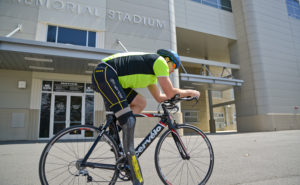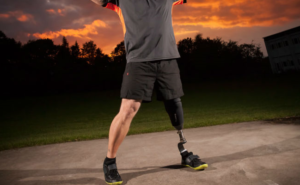Losing a limb to diabetes is life-changing, but your life is not over. It’s just different, and you don’t have to face it alone. The days ahead might feel uncertain, but we’re here to help you know what to expect. From wound care to prosthetics, emotional recovery to day-to-day routine, life after diabetes amputation is covered. You can move ahead with confidence, strength, and the right support. Let’s begin the first step together.
Key Takeaways:
- Wound care starts within 24–48 hours after amputation; signs of infection include swelling, heat, odor, and discharge.
- Clean the wound with mild soap and water; only use creams with doctor approval.
- Emotional recovery may include grief, depression, and anxiety—therapy and support groups help with this.
- Physical rehab begins after healing and includes balance, strength, and adaptive activities like chair workouts or swimming.
- Prosthetic fitting post-surgery depends on healing.
- Phantom limb pain is common and can be eased with therapy, medication, or mirror exercises.
- Managing blood sugar and checking feet daily helps prevent future complications.
- Home adjustments like handrails, ramps, and smart tools improve safety and comfort.
- Returning to work or school takes clear communication, accommodation, and gradual progress.
- Long-term well-being relies on regular care, support, glucose control, and new habits.
The First Steps Toward Life After Diabetes Amputation Begin Immediately
Life after diabetes amputation may feel overwhelming at first, yet the journey to recovery starts the very next day after surgery. Because your medical team begins wound care, monitors your vitals, and assists you in sitting upright, the process of healing is set in motion right away. Although discomfort, dizziness, or unexpected soreness may arise, communication with your care team ensures that concerns are addressed quickly.
In the first days, focusing on rest, balanced meals, and gentle wound protection creates a foundation for progress. Nurses guide you in checking for infection, cleaning gently, and managing dressings, and writing down questions helps make sure none of your concerns are forgotten during appointments.
Proper Wound Care Supports Healing After Diabetes Amputation
Because wound health sets the stage for smooth recovery, clean routines matter at home. Always begin with clean hands, wash the area gently using mild soap and water, and carefully pat dry. Rubbing can irritate, so avoiding friction protects fragile tissue. Dressings provided by your provider must be used and changed as instructed, and if they slip out of place or appear damp, immediate replacement is crucial.
Unless specifically approved by a physician, creams or ointments should be avoided, since some substances delay healing rather than improve it. With daily attention, wound safety reduces complications and speeds readiness for the next stage of life after diabetes amputation.
Infection Awareness Is Central To Life After Diabetes Amputation
Because infection can turn small setbacks into serious challenges, recognizing symptoms early protects your health. Swelling, warmth, unusual odor, and colored drainage rank among the most accurate signs of infection. Increasing pain over several days also signals potential trouble. If fever develops or the skin around the wound turns black, emergency medical care becomes essential.
Keeping daily notes with photographs or written descriptions provides reliable feedback for your physician and helps you notice changes before they escalate. Precision in monitoring ensures safer recovery, particularly in the fragile first weeks of life after diabetes amputation.
Recovery Starts Immediately And Progresses With Small Steps
Since healing begins directly after surgery, the first days hold both challenges and opportunities. While temporary swelling, tiredness, and discomfort are common, deep breathing exercises, proper hydration, and nutritious meals improve energy.
Your first wound check usually arrives within two days, after which you gradually transition into managing your own dressings. Because improper bandage handling can slow recovery, careful re‑wrapping and strict sanitation reduce risks. Should bandages become soaked or stuck to blood or pus, contacting your provider protects long‑term results. Any pale or blackened skin requires urgent evaluation. Therefore, a balance of rest, observation, and communication sets the tone for a safer life after diabetes amputation.
Emotional Healing Strengthens Life After Diabetes Amputation
Although the physical process draws attention first, emotional well-being plays an equal role in recovery. Grief naturally arises, since losing a limb changes not just function but also identity.
Shock, sadness, guilt, or even moments of anger may surface, flowing in waves that take time to ease. Some move forward within weeks, while others find it takes months. If persistent sadness lingers beyond two weeks, professional support can be valuable. Depression may appear in the form of loss of interest or isolation, while anxiety may focus on falling, prosthetics, or stepping into public. Bottled‑up emotions intensify stress, whereas open conversations with trusted people provide release. Counseling, support groups, and therapy programs offer frameworks for building emotional strength.
In fact, embracing supportive relationships often transforms fear into hope, allowing life after diabetes amputation to feel more resilient and meaningful.
Therapy And Support Systems Lighten Emotional Strain
Because professional and peer support help balance self‑image, therapy plays a crucial role in emotional healing.
Talk therapy, trauma-focused guidance, or CBT build coping skills, while journaling, breathwork, and spiritual practices calm stress. Support groups create connections with those who deeply understand your experiences, bridging the isolation many amputees feel. Equally, simple acts from loved ones—cooking, cleaning, sitting together—remind you that care surrounds you. With encouragement, periods of doubt shift into steps of rebuilding identity. Celebrating progress as small as standing up independently or completing an exercise session promotes self-confidence. Each positive step shows that life after diabetes amputation holds opportunity and renewed purpose.
Physical Rehabilitation Shapes Life After Diabetes Amputation
Because regaining strength and mobility is essential, physical rehabilitation begins almost immediately. Initially, therapy focuses on wound safety and circulation through gentle bed exercises like arm raises and healthy limb stretches.
As recovery improves, balance training reduces fall risk, since limb loss alters weight distribution. Under therapist guidance, you practice transferring safely from bed to chair, sitting upright, and shifting weight effectively. In later stages, strength-based exercises restore stamina, including standing practice and safe walking drills. If prosthetic fitting is planned, preparation begins with gentle massage, shrinker socks, or limb shaping to ensure skin integrity.
Even if prosthetics are not chosen, therapists provide strategies for wheelchairs, braces, and practical mobility devices. Each stage builds resilience, reinforcing progress step by step through life after diabetes amputation.
Safe Movements Protect Daily Life After Diabetes Amputation
Because circulation and joint mobility matter, staying active with low‑impact routines helps maintain health. Arm cycles, chair yoga, pool workouts, and resistance band drills all reduce stiffness. Seated exercises with gradual upper‑body strengthening also protect long‑term function. Since diabetic skin remains sensitive, frequent checks for scrapes, blisters, or pressure sores reduce infection chances. Pausing when devices fit poorly prevents worsening injury.
Rehabilitation teams create customized programs and remind patients to avoid prolonged stillness, instead encouraging breaks for movement throughout the day. Through steady, low-impact activity, individuals reinforce independence and strength while embracing healthier life after diabetes amputation.

Adaptive Exercises Offer Confidence And Flexibility
Because one size does not fit all, adaptive routines help each individual thrive. Chair workouts build safe core muscles, while resistance bands strengthen arms and shoulders. Balance drills such as heel raises near counters, seated twists, and pelvic tilts slowly restore stability. Swimming provides joint-friendly, heart-healthy conditioning with minimal stress. Chair yoga, designed for amputees, introduces flexibility and mindfulness without excess strain.
Prosthetics Open Possibilities For Life After Diabetes Amputation
Because prosthetics restore independence, their role can be life changing. After surgery, fitting typically begins within weeks once wounds heal and the limb stabilizes. Physicians refer patients to a skilled prosthetist, who measures the residual limb, prepares liners, and develops a test socket for comfort. Adjustments ensure safe walking without pain or instability, while test devices eventually evolve into permanent solutions.
Options range from shoe inserts for partial-foot amputations, to below-the-knee models with shaft and foot, to above-the-knee systems featuring advanced joint designs. Comfort, lifestyle, and financial considerations shape each choice, and prosthetists carefully guide selection. Typically, prosthetic limbs require replacement every three to five years as bodies change.
By working closely with your therapist and prosthetist, you refine walking skills, posture, and balance, gradually mastering prosthetic use. With time, prosthetics bring smoother movement, reduced back strain, and confident independence, proving that life after diabetes amputation continues with new capabilities.
Common Challenges With Prosthetic Use Improve With Support
Although initial discomfort with prosthetics is normal, proper adjustments solve many issues. Loose sockets, irritated skin, or balance struggles highlight areas needing refinement. Therapists walk step by step through practice sessions, helping fine‑tune posture and weight distribution. While soreness may appear, steady progress and open communication reduce setbacks. Because devices evolve, periodic reassessments ensure long‑term safety.
With persistence, discomfort fades, and prosthetic use becomes part of everyday life. Guidance from Horton’s Orthotics & Prosthetics ensures adjustments, fittings, and support remain accessible during every stage of recovery. In this way, life after diabetes amputation balances technological advances with consistent professional care.
Gentle Guidance Helps Shape Daily Independence
Because strength takes time, patience becomes a companion in the healing journey. Small victories such as walking across a room, preparing a meal, or enjoying community events prove progress is real. Adaptive tools like grab bars, shower chairs, or tailored shoes enhance safety while allowing independence.
Emotional resilience grows alongside physical strength, teaching that identity is shaped by perseverance rather than loss. Friends, family, therapists, and clinics all contribute vital encouragement. Support networks remind each person that they are not alone, and that life after diabetes amputation remains both valuable and fulfilling.
Knowledge And Resources Elevate Confidence
Because informed patients make stronger choices, trusted educational tools benefit every stage. Horton’s shares information about prosthetic fitting, diabetic health tips, and preventative strategies. Regular connection with local Horton’s offices ensures quick access to providers, fittings, and therapies. Ongoing learning keeps families confident, reduces fear of setbacks, and encourages healthy adaptation to new routines. Ultimately, education extends empowerment, and empowerment shapes the best outcomes in life after diabetes amputation.
Take The Next Step Toward Strength And Support
Because each journey after amputation is unique, personalized care creates lasting results. With guidance from compassionate experts, mobility, healing, and confidence return steadily. Horton’s provides decades of experience to make life after diabetes amputation feel manageable, hopeful, and full of opportunity. Begin your path forward today by visiting Horton’s Orthotics & Prosthetics or by connecting directly through the contact page.



